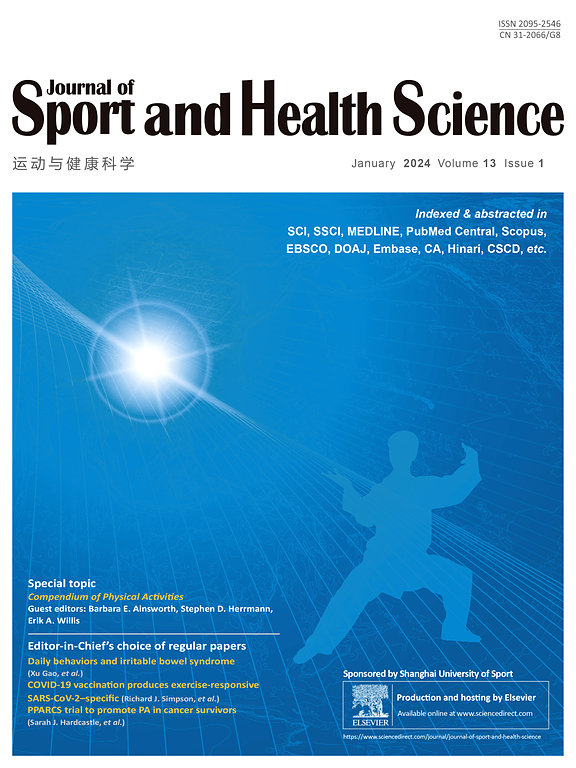Managing lower extremity loading in distance running by altering sagittal plane trunk leaning: Trunk lean: Redistribute loading in running.
IF 9.7
1区 医学
Q1 HOSPITALITY, LEISURE, SPORT & TOURISM
引用次数: 0
Abstract
BACKGROUND Trunk lean angle is an underrepresented biomechanical variable for modulating and redistributing lower extremity joint loading and potentially reducing the risk of running-related overuse injuries. The purpose of this study was to systematically alter the trunk lean angle in distance running using an auditory real-time feedback approach and to derive dose-response relationships between sagittal plane trunk lean angle and lower extremity (cumulative) joint loading to guide overuse load management in clinical practice. METHODS Thirty recreational runners (15 males and 15 females) ran at a constant speed of 2.5 m/s at 5 systematically varied trunk lean conditions on a force-instrumented treadmill while kinematic and kinetic data were captured. RESULTS A change in trunk lean angle from -2° (extension) to 28° (flexion) resulted in a systematic increase in stance phase angular impulse, cumulative impulse, and peak moment at the hip joint in the sagittal and transversal plane. In contrast, a systematic decrease in these parameters at the knee joint in the sagittal plane and the hip joint in the frontal plane was found (p < 0.001). Linear fitting revealed that with every degree of anterior trunk leaning, the cumulative hip joint extension loading increases by 3.26 Nm·s/kg/1000 m, while simultaneously decreasing knee joint extension loading by 1.08 Nm·s/kg/1000 m. CONCLUSION Trunk leaning can reduce knee joint loading and hip joint abduction loading, at the cost of hip joint loading in the sagittal and transversal planes during distance running. Modulating lower extremity joint loading by altering trunk lean angle is an effective strategy to redistribute joint load between/within the knee and hip joints. When implementing anterior trunk leaning in clinical practice, the increased demands on the hip musculature, dynamic stability, and the potential trade-off with running economy should be considered.通过改变矢状面躯干倾斜来控制长跑中的下肢负荷:躯干倾斜:重新分配跑步时的负荷。
背景躯干倾角是一个未得到充分反映的生物力学变量,它可以调节和重新分配下肢关节负荷,并有可能降低与跑步相关的过度劳损风险。本研究的目的是利用听觉实时反馈方法系统地改变长跑中的躯干倾斜角,并得出矢状面躯干倾斜角与下肢(累积)关节负荷之间的剂量-反应关系,以指导临床实践中的过度使用负荷管理。结果躯干倾斜角度从-2°(伸展)到 28°(屈曲)的变化导致矢状面和横向面上站立阶段角冲量、累积冲量和髋关节峰值力矩的系统性增加。相反,在矢状面的膝关节和正面的髋关节处,这些参数出现了系统性下降(p < 0.001)。线性拟合结果显示,躯干前倾每增加一度,髋关节伸展负荷的累积值就会增加 3.26 Nm-s/kg/1000m,同时膝关节伸展负荷减少 1.08 Nm-s/kg/1000m。通过改变躯干倾斜角度来调节下肢关节负荷是在膝关节和髋关节之间/内部重新分配关节负荷的有效策略。在临床实践中实施躯干前倾时,应考虑到对髋关节肌肉组织、动态稳定性的更高要求,以及对跑步经济性的潜在权衡。
本文章由计算机程序翻译,如有差异,请以英文原文为准。
求助全文
约1分钟内获得全文
求助全文
来源期刊

Journal of Sport and Health Science
SPORT SCIENCES-
CiteScore
18.30
自引率
1.70%
发文量
101
审稿时长
22 weeks
期刊介绍:
The Journal of Sport and Health Science (JSHS) is an international, multidisciplinary journal that aims to advance the fields of sport, exercise, physical activity, and health sciences. Published by Elsevier B.V. on behalf of Shanghai University of Sport, JSHS is dedicated to promoting original and impactful research, as well as topical reviews, editorials, opinions, and commentary papers.
With a focus on physical and mental health, injury and disease prevention, traditional Chinese exercise, and human performance, JSHS offers a platform for scholars and researchers to share their findings and contribute to the advancement of these fields. Our journal is peer-reviewed, ensuring that all published works meet the highest academic standards.
Supported by a carefully selected international editorial board, JSHS upholds impeccable integrity and provides an efficient publication platform. We invite submissions from scholars and researchers worldwide, and we are committed to disseminating insightful and influential research in the field of sport and health science.
 求助内容:
求助内容: 应助结果提醒方式:
应助结果提醒方式:


